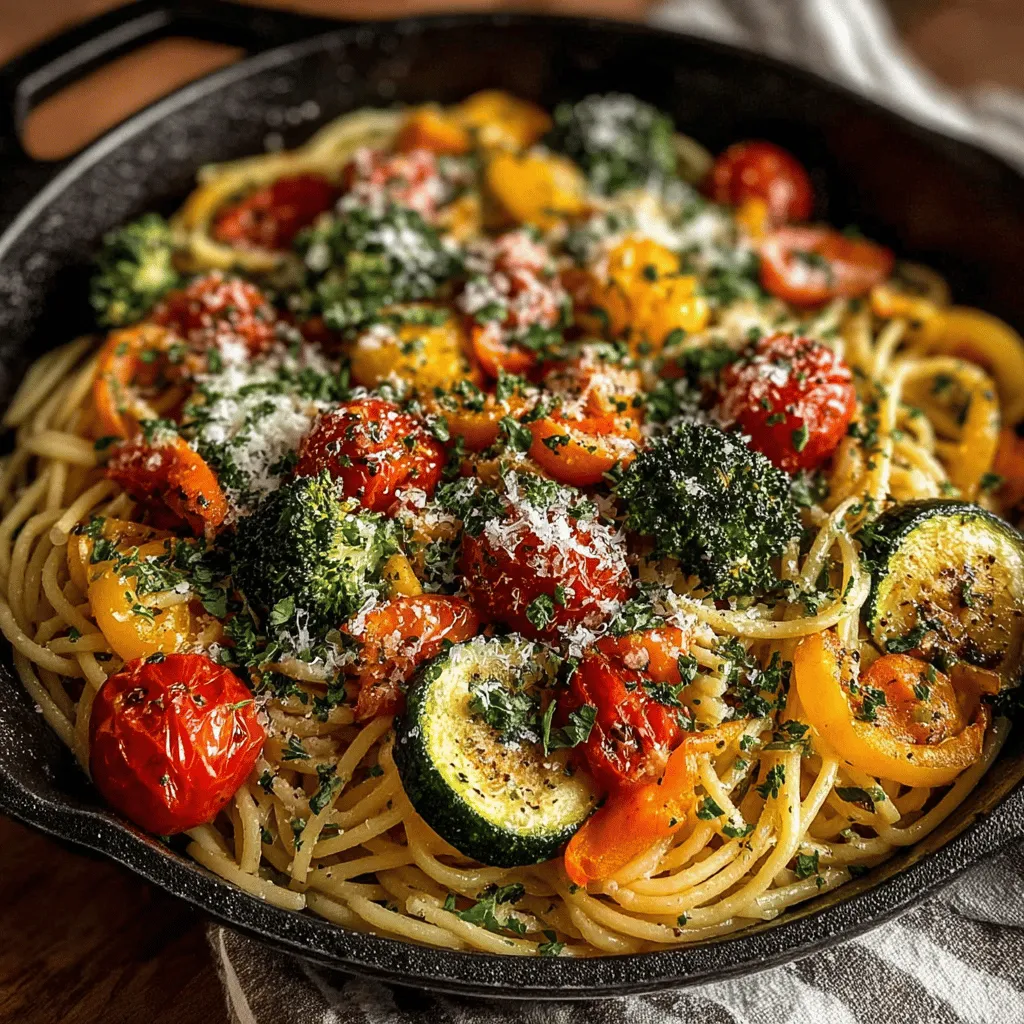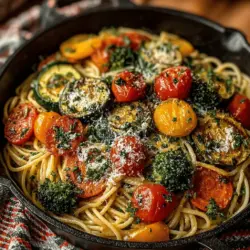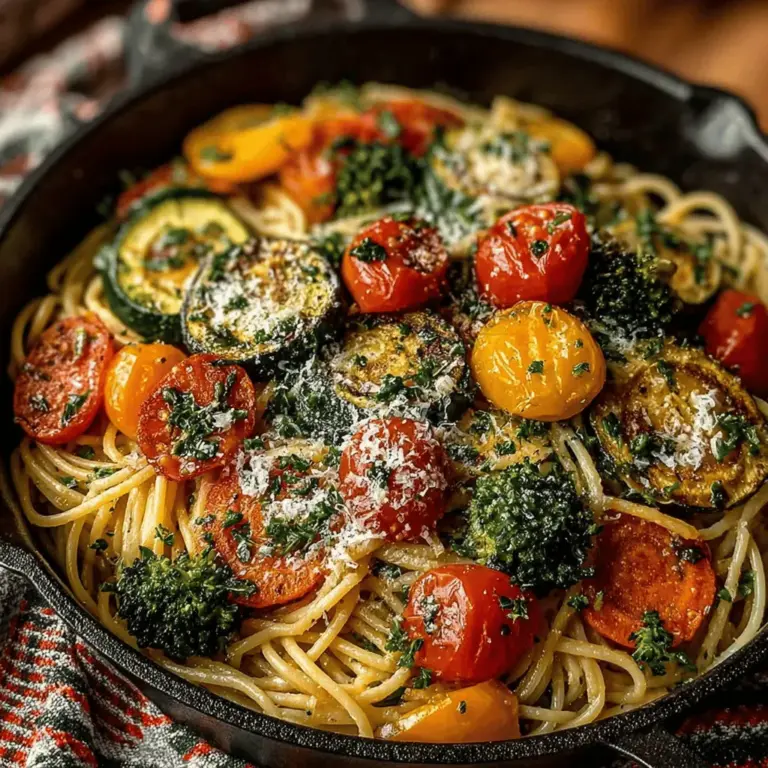Introduction
In today’s fast-paced world, finding nutritious and delicious meals that can be prepared quickly is essential. One such delightful option is the Colorful Veggie-Packed Pasta Primavera Skillet. This dish not only bursts with vibrant colors but is also loaded with a variety of vegetables, making it a wholesome choice for both families and busy professionals. In this article, we will explore the benefits of this pasta primavera, walk through the recipe step-by-step, and discuss the nutritional advantages of each ingredient.
Ingredients
– 8 ounces whole wheat spaghetti or linguine
– 2 tablespoons olive oil
– 1 medium onion, diced
– 3 cloves garlic, minced
– 1 bell pepper, sliced (any color)
– 1 medium zucchini, sliced
– 1 large carrot, julienned
– 1 cup cherry tomatoes, halved
– 1 cup broccoli florets
– 1 teaspoon Italian seasoning
– Salt and pepper to taste
– Fresh parsley, chopped (for garnish)
– Grated Parmesan cheese (optional)
Instructions
1. Cook the Pasta: In a large pot of boiling salted water, cook the whole wheat spaghetti or linguine according to package instructions until al dente. Reserve 1 cup of pasta water, then drain the pasta and set aside.
2. Sauté the Vegetables: In a large skillet, heat the olive oil over medium heat. Add the diced onion and garlic, cooking until fragrant and translucent, about 2-3 minutes.
3. Add Bell Pepper and Carrot: Stir in the sliced bell pepper and julienned carrot, cooking for an additional 3-4 minutes until they begin to soften.
4. Incorporate Zucchini and Broccoli: Add the sliced zucchini and broccoli florets to the skillet. Continue to sauté for another 3-4 minutes until all the vegetables are tender yet still vibrant in color.
5. Mix in Tomatoes and Seasoning: Stir in the halved cherry tomatoes and Italian seasoning. Season with salt and pepper to taste, and cook for another 2 minutes.
6. Combine Pasta and Vegetables: Add the cooked pasta to the skillet, tossing well to combine. If the mixture seems dry, gradually add reserved pasta water until the desired consistency is achieved.
7. Serve: Garnish with fresh parsley and, if desired, sprinkle grated Parmesan cheese on top before serving warm.
Understanding Pasta Primavera
Defining Pasta Primavera and Its Origins
Pasta primavera, which translates to “spring pasta” in Italian, is a dish that emphasizes fresh vegetables and vibrant flavors. Traditionally created in the mid-20th century in the United States, it draws inspiration from Italian cuisine, focusing on seasonal produce. Over time, pasta primavera has evolved, adapting to various culinary cultures while maintaining its core element—celebrating the freshness of vegetables.
The Appeal of Colorful Veggie-Packed Meals
Incorporating a variety of vegetables into our meals is crucial for a balanced diet. Colorful meals not only enhance visual appeal but also promote higher nutrient intake. Each hue often represents different vitamins and minerals, contributing to overall health. The Colorful Veggie-Packed Pasta Primavera Skillet exemplifies this concept by combining a rainbow of vegetables, making it both a feast for the eyes and a boost for your health.
Ingredients Breakdown
Whole Wheat Spaghetti or Linguine
Whole grains are an essential part of a healthy diet, providing fiber, vitamins, and minerals. When selecting pasta for this dish, whole wheat options like spaghetti or linguine offer a nutty flavor and a satisfying texture while promoting better digestion and sustained energy levels.
The Role of Fresh Vegetables
This recipe incorporates a variety of fresh vegetables, including onion, garlic, bell pepper, zucchini, carrot, cherry tomatoes, and broccoli. Each of these ingredients brings unique nutritional benefits. For instance, broccoli is rich in vitamin C and fiber, while bell peppers are packed with antioxidants.
Herbs and Seasonings
Italian seasoning plays a pivotal role in enhancing the flavors of this dish. By using a blend of herbs such as basil, oregano, and thyme, you can infuse the pasta primavera with a fragrant aroma. Additionally, fresh parsley adds a burst of freshness that elevates the overall taste experience.
Step-by-Step Cooking Instructions
Cooking the Pasta: Getting it Just Right
Cooking pasta al dente is crucial for achieving the right texture. This method ensures that the pasta retains a slight firmness, providing the perfect bite that complements the tender vegetables. Remember to reserve some pasta water before draining, as it can be used to create a flavorful sauce that brings the entire dish together.
Sautéing the Vegetables to Perfection
Sautéing the vegetables is key to developing their flavors. Start with the aromatics, like onion and garlic, before adding the heartier vegetables. This technique allows each ingredient to cook evenly, ensuring a delicious blend of tastes and textures in your pasta primavera.

Techniques for Sautéing Onions and Garlic
Unlocking Flavor
To bring out the best flavors in your onions and garlic, start by heating a quality olive oil in your skillet over medium heat. Add the onions first, allowing them to sauté until they become translucent and fragrant, typically 5-7 minutes. This process caramelizes the natural sugars in the onions, enhancing their sweetness and depth.
Once the onions are ready, introduce minced garlic. Garlic cooks quickly, so stir it in for just 1-2 minutes until it becomes fragrant but not browned, as burnt garlic can impart a bitter taste.
Timing for Adding Different Vegetables
Achieving Optimal Tenderness
The key to a perfectly cooked Pasta Primavera lies in the timing of adding your vegetables. Start with those that require longer cooking times, such as bell peppers and carrots, letting them sauté for about 3-5 minutes. Next, incorporate quicker-cooking vegetables like zucchini and cherry tomatoes, which need just 2-3 minutes to soften without losing their vibrant color and crunch.
To ensure all vegetables are perfectly tender without being mushy, keep an eye on their texture as they cook, adjusting the timing based on your preferences.
Combining Flavors: Creating a Delicious Sauce
Seasoning and Harmonizing Ingredients
To craft a flavorful sauce that complements your vegetables and pasta, consider adding a splash of vegetable broth or reserved pasta water after the veggies have sautéed. This addition not only helps to deglaze the pan, lifting any delicious bits stuck to the bottom, but also creates a light sauce that clings beautifully to the pasta.
Season the mixture with salt, pepper, and herbs such as basil or oregano to enhance the overall flavor profile. Taste and adjust the seasoning as you go, ensuring every bite is well-balanced.
Bringing It All Together
Tossing Pasta and Vegetables
Once your pasta is cooked al dente, reserve some pasta water before draining. Add the drained pasta directly to the skillet with the sautéed vegetables. Toss everything together gently, adding a bit of the reserved pasta water if needed to help the sauce coat the pasta evenly. This method ensures that the pasta absorbs the flavors of the vegetables and sauce.
Adjusting Seasoning
After mixing, taste your dish once more. Adjust seasoning as desired, adding more herbs or a squeeze of lemon juice for brightness. This is your chance to personalize the dish to your taste.
Serving Suggestions
Plating the Pasta Primavera
When it comes to presentation, a beautiful plate can elevate the dining experience. Serve the Pasta Primavera in a shallow bowl or on a wide plate, allowing the colorful vegetables to shine.
Garnishing Tips
Consider garnishing your dish with freshly chopped parsley or basil for a pop of color and flavor. A sprinkle of grated Parmesan or a drizzle of balsamic reduction can also enhance both the visual appeal and taste.
Pairing Options
For a well-rounded meal, pair your Pasta Primavera with a simple side salad, perhaps a mixed greens salad dressed with a light vinaigrette. Crusty whole-grain bread or garlic bread can also complement the dish beautifully.
For beverage pairings, a crisp white wine like Pinot Grigio or a refreshing sparkling water with lemon can enhance your dining experience.
Nutritional Benefits of the Dish
Caloric Breakdown and Nutritional Value
A typical serving of Pasta Primavera is filled with nutrients while being relatively low in calories, making it a great option for health-conscious individuals. The calorie count can vary based on ingredient choices, but with a focus on vegetables and whole grains, this dish packs a nutritious punch.
Highlighting Vitamins and Minerals
This dish is rich in vitamins A and C, potassium, and dietary fiber, thanks to the variety of colorful vegetables used. These nutrients contribute to overall health and well-being.
Health Benefits of Consuming Vegetables
Incorporating a rainbow of vegetables into your diet can lead to numerous health benefits, including improved digestion, weight management, and a reduced risk of chronic diseases. This Pasta Primavera is an excellent way to increase your vegetable intake, fitting seamlessly into vegetarian and gluten-free diets.
Conclusion
The Colorful Veggie-Packed Pasta Primavera Skillet is not just a meal; it is a celebration of fresh ingredients and flavors. This dish exemplifies how easy it can be to enjoy healthy, homemade meals without sacrificing taste or time. By incorporating a variety of vegetables and whole grains, you not only create a visually appealing plate but also nourish your body. Whether you are preparing dinner for your family or meal prepping for the week ahead, this pasta primavera is a versatile and satisfying option that meets diverse dietary needs while delighting the palate.

